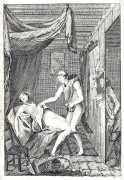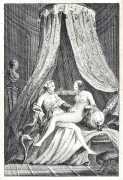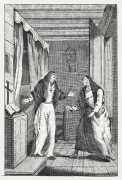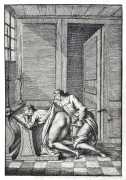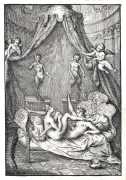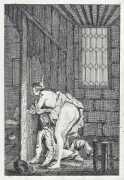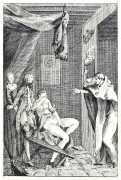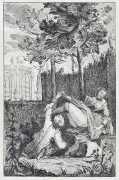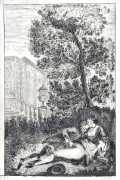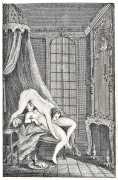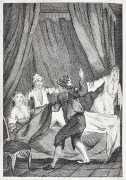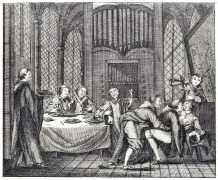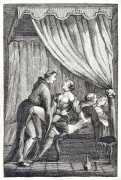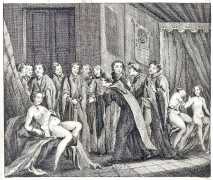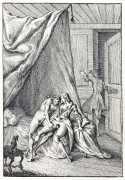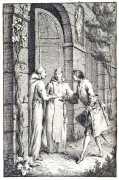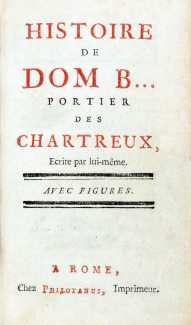 Histoire de Dom B…, Portier des Chartreux (The Story of Dom Bougre, Porter of the Charterhouse) is one of the earliest and most famous erotic novels of the French Enlightenment. A truly libertine novel, flouting moral as well as religious conventions, its main character is Saturnin, the illegitimate son of a priest, who has inherited his father’s lecherous predilections. He quickly acquires a sexual education with the enthusiastic assistance of Suzon and Toinette, the women he believes to be his sister and his mother, and his sister’s godmother, Madame d’Inville. After entering a Celestine convent he is forced to endure years of abstinence, but is eventually admitted to the monks’ secret harem, where more pleasures await him to the point of satiety. After he finds Suzon by chance in a disreputable brothel, his last encounter with her gives him a case of the pox so severe that only castration can save his life, and the disease proves fatal to her. Filled with despair and rage, he seeks entrance to the Carthusian monastery in Paris, where he assumes the post of porter and remains for the rest of his life.
Histoire de Dom B…, Portier des Chartreux (The Story of Dom Bougre, Porter of the Charterhouse) is one of the earliest and most famous erotic novels of the French Enlightenment. A truly libertine novel, flouting moral as well as religious conventions, its main character is Saturnin, the illegitimate son of a priest, who has inherited his father’s lecherous predilections. He quickly acquires a sexual education with the enthusiastic assistance of Suzon and Toinette, the women he believes to be his sister and his mother, and his sister’s godmother, Madame d’Inville. After entering a Celestine convent he is forced to endure years of abstinence, but is eventually admitted to the monks’ secret harem, where more pleasures await him to the point of satiety. After he finds Suzon by chance in a disreputable brothel, his last encounter with her gives him a case of the pox so severe that only castration can save his life, and the disease proves fatal to her. Filled with despair and rage, he seeks entrance to the Carthusian monastery in Paris, where he assumes the post of porter and remains for the rest of his life.
Histoire de Dom B… was rarely out of print, and thirty editions of the work appeared between 1740 and 1920 under various related titles including Histoire de Gouberdom (1772), Le portier des Chartreux (1784), Mémoires de Saturnin (1787), and Histoire de Saturnin (1908). Its initial publication sparked a four-month campaign of police activity, in futile attempts to identify and arrest the novel’s author, illustrator, engraver and printer, and in seizures of caches of bound and unbound copies. The book was officially banned many times over the next hundred years, with editions nominally being published abroad, as with this one ‘in Rome’, but it was always possible to obtain a copy if you knew the right contacts.
The 1740 edition of Dom B… contains eighteen anonymous engravings, all of them erotic apart from the last one, which depicts Saturnin’s reception by the Carthusians. In this copy, held by the Biblioteque Nationale de France, three of the engravings are misplaced – the 11th, 15th and 17th. The images are presented in the correct order here.
As explained in the Antoine Borel portfolio of engravings for the 1787 edition of Mémoires de Saturnin, which you can see here, the text has been attributed to Jean-Charles Gervaise de Latouche (1715–82), an attorney at the Parlement de Paris, who may also have written two more licentious works, Mémoires de Mademoiselle de Bonneval (1738) and Lyndamine, ou L’Optimisme des Pays Chauds (The Optimism of the Hot Countries, 1778).
We are very grateful to our Texan colleague Phyllis Eccleston for the research and images presented here.


